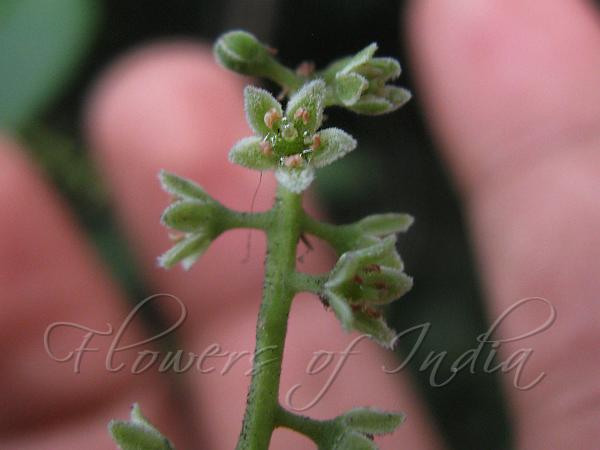|
| Vidang |
|

|

| File size | 700978 |
| Original date | 2/5/14 6:14 PM |
| Resolution | 2028 x 1521 |
| Flash | Flash did not fire, auto |
| Focal length | 6.0mm |
| Exposure time | 1/20s |
| Aperture | 2.8 |
| Focus Distance | 0.08m |
| Metering Mode | Multi-segment |
| Camera make | Canon |
| Camera model | Canon PowerShot SX110 IS |
| Sensor type | OneChipColorArea |
|
|
|
|
Photo: |
Botanical name: Embelia ribes Family: Primulaceae (Primrose family)
Synonyms: Embelia paniculata, Antidesma ribes
Synonyms: Embelia paniculata, Antidesma ribes
Vidanga is a climber with branchlets slender,
white, without warts. Leaves are up to 7 x 3 cm, elliptic, pointed at
both ends; nerves many, parallel, faint; leaf-stalk 1 cm long. Flowers
are borne in panicles 15 x 15 cm, hairless, branches long, slender
racemose; flower-stalks 1.5 cm long. Flowers are white, many; sepals
small, triangular, woolly; petals 2 mm long, ovate, pointed, densely
woolly. Berry is 2.5 mm across, spherical. Vidanga is found in
Indo-Malesia and South China. It is also found in the Himalayas,
at altitudes of 100-2000 m.
Medicinal uses: In Ayurveda, Vidanga improves
the functioning of the digestive system and alleviates flatulence,
gaseous belching and constipation. Vidanga is especially useful in
expelling the tape worm out of the digestive system. Besides this
Vidanga is also useful in Vata disorders like facial paralysis,
epilepsy and insanity.
In Ayurveda, Vidanga improves
the functioning of the digestive system and alleviates flatulence,
gaseous belching and constipation. Vidanga is especially useful in
expelling the tape worm out of the digestive system. Besides this
Vidanga is also useful in Vata disorders like facial paralysis,
epilepsy and insanity.
Medicinal uses:
 In Ayurveda, Vidanga improves
the functioning of the digestive system and alleviates flatulence,
gaseous belching and constipation. Vidanga is especially useful in
expelling the tape worm out of the digestive system. Besides this
Vidanga is also useful in Vata disorders like facial paralysis,
epilepsy and insanity.
In Ayurveda, Vidanga improves
the functioning of the digestive system and alleviates flatulence,
gaseous belching and constipation. Vidanga is especially useful in
expelling the tape worm out of the digestive system. Besides this
Vidanga is also useful in Vata disorders like facial paralysis,
epilepsy and insanity. | Identification credit: Siddarth Machado | Photographed in Sakleshpur, Karnataka. |
• Is this flower misidentified? If yes,